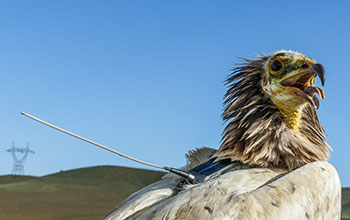Multimedia Gallery
Egyptian vulture fitted with solar-powered GPS transmitter
An Egyptian vulture in Turkey is fitted with a solar-powered GPS transmitter as part of the LIFE+ project, "The Return of the Neophron."
More about this image
Researchers with the University of Utah, working with the LIFE+ project, "The Return of the Neophron," caught and tagged a total of 45 Egyptian vultures from 2012 to 2016 to learn more about where they eat, breed and migrate. Results from the study will aid in future conservation efforts in countries that these birds pass through during their annual migrations.
The researchers found that the vultures migrate along the Red Sea Flyway, a large area connecting the summer and winter ranges of birds in Eastern Europe, Central Asia, the Middle East and Africa, and that their travel routes revealed migratory bird corridors and bottlenecks.
Determining where bottlenecks exists -- places where birds concentrate on migration -- helps bird conservationists know what areas to focus on, since a large percentage of a species’ population can pass through these small areas.
"The Red Sea Flyway connects birds from Eastern Europe, Central Asia, the Middle East -- all those birds that migrate into Africa," says Evan Buechley, a postdoctoral scholar at the University of Utah and HawkWatch International. "But because of political instability in some countries and harsh desert environs throughout, it’s minimally studied. There’s not a lot of conservation happening. It’s a big research gap."
The vultures are just one of around 35 large, soaring bird species that migrate along the Red Sea Flyway. Dozens more small birds migrate here as well. It’s the second-largest migratory flyway in the world, behind only the Americas Flyway, which connects North and South America.
After identifying key bottleneck locations, the researchers checked to see how well protected the areas are; that is, within the most important bird bottlenecks, is there any federal protection from the nations in which they sit? The answer was none, although some of the Important Bird and Biodiversity Areas (IBAs) -- places recognized for their international importance for conservation -- do overlap some of these areas and future work could focus on these sites.
Recognizing the importance of such bottlenecks is vital in influencing developments that may harm birds on migration. For example, a company building a wind farm -- one of the major hazards that vultures face along their journeys -- can assess how likely it is that their turbines may affect migrating birds. Illegal shooting and poisoning is also a concern throughout their migratory ranges, Buechley says.
The research was conducted as part of the LIFE+ project, "The Return of the Neophron," which was supported in part by the National Science Foundation (grant DGE 1256065).
Read more in the University of Utah news story Vultures reveal critical old world flyways, or learn more about the project "The Return of the Neophron." (Date image taken: 2015; date originally posted to NSF Multimedia Gallery: June 28, 2018)
Credit: Evan R. Buechley, University of Utah/HawkWatch International
See other images like this on your iPhone or iPad download NSF Science Zone on the Apple App Store.
Images and other media in the National Science Foundation Multimedia Gallery are available for use in print and electronic material by NSF employees, members of the media, university staff, teachers and the general public. All media in the gallery are intended for personal, educational and nonprofit/non-commercial use only.
Images credited to the National Science Foundation, a federal agency, are in the public domain. The images were created by employees of the United States Government as part of their official duties or prepared by contractors as "works for hire" for NSF. You may freely use NSF-credited images and, at your discretion, credit NSF with a "Courtesy: National Science Foundation" notation.
Additional information about general usage can be found in Conditions.
Also Available:
Download the high-resolution JPG version of the image. (4.5 MB)
Use your mouse to right-click (Mac users may need to Ctrl-click) the link above and choose the option that will save the file or target to your computer.

 All images in this series
All images in this series